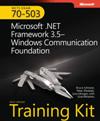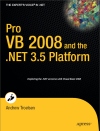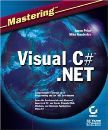作者:Ingo Rammer
出版日期:April 5, 2002
出版社:Apress
页数:404
ISBN:ISBN-10: 1590590252 ISBN-13: 978-1590590256
文件格式:CHM
Review
With the arrival of .NET remoting, any programmer who wants to work with distributed objects can benefit from Advanced .NET Remoting, a solid tour of basic and expert techniques for working with distributed code on Microsoft’s newest platform.
This title’s concise, code-centered approach, backed up by judiciousdiscussion of the finer technical points of .NET, is what helps make ita success. After touring the history of standards used for distributedcomputing over the years, from DCE/RPC to CORBA to COM and relatedMicrosoft technologies, the author zeroes in on .NET remoting. Short,digestible examples highlight the relevant objects and APIs useful tocreate and invoke objects remotely. From the basics, the book movesforward with other possibilities for designers, whether using by valueor reference arguments for objects, client-activated vs.server-activated objects, and a useful section on asynchronousprocessing for remote function calls. Early examples use the APIs andstrategies you’ll need to work on your own, and the author highlights“best practices” like using class factories.
Detailed discussion of deployment options (using XML) is followed bya quick discussion of security and authentication and then managingobject lifetimes (including programmatic options through leasing andsponsors). Coverage of using strongly named assemblies (for the GlobalAssembly Cache, GAC) and versioning stresses the finer points of howdifferent versions of .NET components can be invoked on the same server.
For experts, there’s a fine section that covers .NET remotinginternals, explains the details of making distributed calls in .NET,and shows off how messages are formatted and passed between systemsthrough proxies. Excellent use of sequence diagrams showing thesefeatures at work will make this chapter invaluable for the advancedreader (though you still use the sample code without having to masterthese .NET internals).
The book returns to its pragmatic focus with some interesting samplecode for compressing and encrypting .NET remote messages with built-insupport classes in .NET. A highly developed chapter demonstrates howyou use custom transport channel to make remote calls via e-mail(through SMTP and POP3), showing off the flexibility of the .NETprogramming model. For the truly adventurous developer, a final chapterexplores several (undocumented) features for examining and using context objects used in the .NET remoting model.
Overall, this concisely packaged book mixes the right level ofsample code, detailed explanation, and advanced material that will letC# developers get going fast with .NET remoting, which can greatlysimplify distributed programming on the new Windows platform. –Richard Dragan
Topics covered: Introduction to .NET remoting,history of distributed computing mechanisms (including DCE/RPC, CORBA,and COM to .NET), advantages of .NET remoting (and architecture), asimple getting started program using .NET remoting with a server andclient, adding validation, types of remoting (passing objects by valueand reference, singletons, published objects), using factories tocreate objects, server-activated vs. client-activated objects, lifetimemanagement, synchronous vs. asynchronous function calls, multi-serverprogramming, shared assemblies (and the soapsuds utility andproxies), configuration (XML config. files and standard options),deployment (console vs. Windows services vs. IIS), security issues(authentication and checking roles), using SSL and encryption, objectlifetime management (lease time and managers, server-side sponsors),versioning for .NET components (strong naming and the Global AssemblyCache, GAC), delegate and events (tips for event handling), .NETremoting internals (proxies, messages, message sinks, formatters, andtransport channels), internals of asynchronous processing, advancedsink programming (client-, server-side, and dynamic sinks), extending.NET remoting (including message compression and encryption support),custom transport channels (using POP3/SMTP), and undocumentedtechniques for working with .NET remoting context objects.
Review
Intermediate to advanced developers will appreciate this book iflooking for an in-depth, no holds barred discussion of .NET remoting. —Slashdot.org







 评论 (0)
评论 (0) 